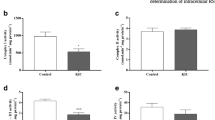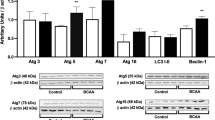Abstract
In the current study we investigated the effect of the branched-chain alpha-keto acids (BCKA) α-ketoisocaproic (KIC), α-keto-β-methylvaleric (KMV), and α-ketoisovaleric (KIV) acids, which accumulate in maple syrup urine disease (MSUD), on the in vitro uptake of [3H]glutamate by cere-bral cortical slices from rats aged 9, 21, and 60 days of life. We initially observed that glutamate uptake into cerebral cortex of 9- and 21-day-old rats was significantly higher, as compared to that of 60-day-old rats. Furthermore, KIC inhibited this uptake by tissue slices at all ages studied, whereas KMV and KIV produced the same effect only in cortical slices of 21- and 60-day-old rats. Kinetic assays showed that KIC significantly inhibited glutamate uptake in the presence of high glutamate concentrations (50 μM and greater). We also verified that the reduction of glutamate uptake was not due to cellular death, as evidenced by tetrazolium salt and lactate dehydrogenase viability tests of cortical slices in the presence of the BCKA. It is therefore presumed that the reduced glutamate uptake caused by the BCKA accumulating in MSUD may lead to higher extracellular glutamate levels and potentially to excitotoxicity, which may contribute to the neurological dysfunction of the affected individuals.
Similar content being viewed by others
references
Nord, A., Van Doornick, W. J., and Greene, C. 1991. Developmental profile of patients with maple syrup urine disease. J. Inherit. Metab. Dis. 14:881–889.
Chuang, D. T., and Shih V. E. 2001. Disorders of branched chain amino acid and keto acid metabolism. Pages 1971–2005, in Scriver, C. R., Beaudet, A. L., Sly, W. L., Valle, D. (eds.), The Metabolic and Molecular Bases of Inherited Disease, McGraw-Hill, New York.
Nyan, W. L. 1984. Abnormalities in amino acid metabolism in clinical medicine. Norwalk, CT: Appleton-Century-Crofts.
Snyderman, E., Norton, P. M., and Roitman, B. 1964. Maple syrup urine disease, with particular reference to dietotherapy. Pediatrics 34:454–472.
Danner, D. J., and Elsas, L. J. 1989. Disorders of branched chain amino acid and keto acid metabolism. Pages 671–692, in Scriver, C. R., Beaudet, A. L., Sly, W. L., Valle, D. (eds.), The Metabolic Basis of Inherited Disease, McGraw-Hill, New York.
Fonnun, F. 1984. Glutamate: A neurotransmitter in mammalian brain. J. Neurochem. 42:1–11.
Ottersen, O. P., and Storm-Mathisen, J. 1984. Neurons containing or accumulating transmitter amino acids. Pages 141–246, in Björklund, A., Hökfelt, T., Kuhar, M. J. (eds.), Handbook of Chemical Neuroanatomy: Classical Transmitters and Transmitter Receptors in the CNS, Elsevier, Amsterdam.
Collingridge, G. L., and Lester, R. A. J., 1989. Excitatory amino acid receptors in the vertebrate central nervous system. Pharmacol. Rev. 40:143–210.
Headley, P. M., and Grillner, S. 1990. Excitatory amino acids and synaptic transmission: The evidence for a physiological function. Trends Pharmacol. Sci. 11:205–211.
Ozawa, S., Kamyia, H., and Tsuzuki, K. 1998. Glutamate receptors in the mammalian central nervous system. Prog. Neurobiol. 54:581–618.
Danbolt N. C. 2001. Glutamate uptake. Prog. Neurobiol. 65:1–105.
Nicholls, D. G. 1993. The glutamatergic nerve terminal. Eur. J. Biochem. 212:613–631.
Maragaskis, N. J., and Rothstein, J. D. 2001. Glutamate transporters in neurologic disease. Arch. Neurol. 58:365–370.
Nieollon, A., and Kerkerian-Le Goff, L. 1983. Presynaptic control of high affinity glutamate uptake in the striatum. Neurosci. Lett. 43:191–196.
Greenamyre, J. T. and Young, A. B. 1989. Excitatory amino acids and Alzheimer's disease. Neurobiol. Aging 10:593–602.
Gilad, G. M., Gilad, V. H., Wyatt, R. J., and Tizabi, Y. 1990. Region-selective stress-induced increase of glutamate uptake and release in rat forebrain. Brain Res. 525:335–338.
Rothstein, J. D., Martin, L. J., and Kuncl, R. W. 1992. Decreased brain and spinal cord glutamate transport in amyotrophic lateral sclerosis. New Engl. J. Med. 326:1464–1468.
Lipton, S. A., and Rosemberg, P. A. 1994. Excitatory amino acid as a final common pathway for neurologic disorders. New Engl. J. Med. 330:613–622.
Price, D. L. 1999. New order from neurologic diseases. Nature 399(Suppl. 24A):3–5.
Kanner, B. I. 1993. Glutamate transporters from brain: A novel neurotransmitter transport family. FEBS Lett. 325:95–99.
Amara, S. G., and Fontana C. K. 2002. Excitatory amino acid transporters: Keeping up with glutamate. Neurochem. Int. 41:313–318.
Frizzo, M. E. S., Lara, D. R., Prokopiuk, A. S., Vargas, C. R., Salbego, C. G., Wajner, M., and Souza, D. O. 2002. Guanosine enhances glutamate uptake in brain cortical slices at normal and excitotoxic conditions. Cell. Mol. Neurobiol. 22:353–363.
Peterson, G. L. 1977. Review of the folin phenol protein quantitation method of Lowry. Anal. Biochem. 83:346–356.
Funchal, C., de Lima Pelaez, P., Oliveira Loureiro, S., Vivian L, Dall Bello Pessutto, F., Vieira de Almeida, L. M., Wofchuk, S. T., Wajner, M., and Pessoa-Pureur, R. 2002. α-Ketoisocaproic acid regulates phosphorylation of intermediate filaments in postnatal rat cortical slices throught ionotropic glutamate receptors. Dev. Brain Res. 139:267–276.
Coitinho, A. S., de Mello, C. F., Fortes Lima, T. T., de Bastiani, J., Rechia Fighera, M., and Wajner, M. 2001. Pharmacological evidence that α-ketoisovaleric acid induces convulsions though GABAergic and glutamatergic mechanisms in rats. Brain Res. 894:68–73.
Tavares, R. G., Santos, C. E. S., Tasca, C. I., Wajner, M., Souza, D. O., and Dutra-Filho, C. S. 2000. Inhibition of glutamate uptake into synaptic vesicles of rat brain by the metabolites accumulating in maple syrup urine disease. J. Neurol. Sci. 181:44–49.
Anderson, K. J., Mason, K. L., McGraw, T. S., Theophilopoulos, D. T., Sapper, M. S., and Burchfield, D. J. 1999. The ontogeny of glutamate receptors and D-aspartate binding sites in the ovine CNS. Dev. Brain Res. 118:69–77.
Furuta, A., Rothstein, J. D., and Martin, L. J. 1997. Glutamate transporter protein subtypes are expressed differentially during rat CNS development. J. Neurosci. 17:8363–8375.
Sutherland, M. L., Delaney, T. A., and Noebels, J. L. 1996. Glutamate transporter mRNA expression in proliferative zones of the developing and adult murine CNS. J. Neurosci. 16:2191–2207.
Rothstein, J. D., Van Kammen, M., Levey, A. I., Martin, L. J., and Kuncl, R. W. 1995. Selective loss of glial glutamate transporter GLT-1 in amyotrophic lateral sclerosis. Ann. Neurol. 38:73–84.
Meldrum, B. S. 2000. Glutamate as a neurotransmitter in the brain: Review of physiology and pathology. J. Nutr. 130:1007S–1015S.
Howell, R. K., and Lee, M. 1963. Influence of alpha-ketoacids on the respiration of brain in vitro. Proc. Soc. Exp. Biol. Med. 113:660–663.
Halestrap, A. P., Brand, M. D., and Denton, R. M. 1974. Inhibition of mitochondrial pyruvate transport by phenylpyruvate and α-ketoisocaproate. Biochem. Biophys. Acta 367:102–108.
Land, J. M., Mowbray, J., and Clark, J. B. 1976. Control of pyruvate and β-hydroxybutirate utilization in rat brain mitochondria and its relevance to phenylketonuria and maple syrup urine disease. J. Neurochem. 26:823–830.
Pilla, C., Cardozo, R. F., Dutra-Filho, C. S., Wyse, A. T., Wajner, M., and Wannmacher, C. M. 2003. Creatine kinase activity from rat brain is inhibited by branched-chain amino acids in vitro. Neurochem. Res. 28:675–679.
Beal, M. E. 1995. Aging, energy and oxidative stress in neurodegenerative diseases. Ann. Neurol. 38:357–366.
Author information
Authors and Affiliations
Rights and permissions
About this article
Cite this article
Funchal, C., Rosa, A.M., Wajner, M. et al. Reduction of Glutamate Uptake into Cerebral Cortex of Developing Rats by the Branched-Chain Alpha-Keto Acids Accumulating in Maple Syrup Urine Disease. Neurochem Res 29, 747–753 (2004). https://doi.org/10.1023/B:NERE.0000018846.66943.30
Issue Date:
DOI: https://doi.org/10.1023/B:NERE.0000018846.66943.30




